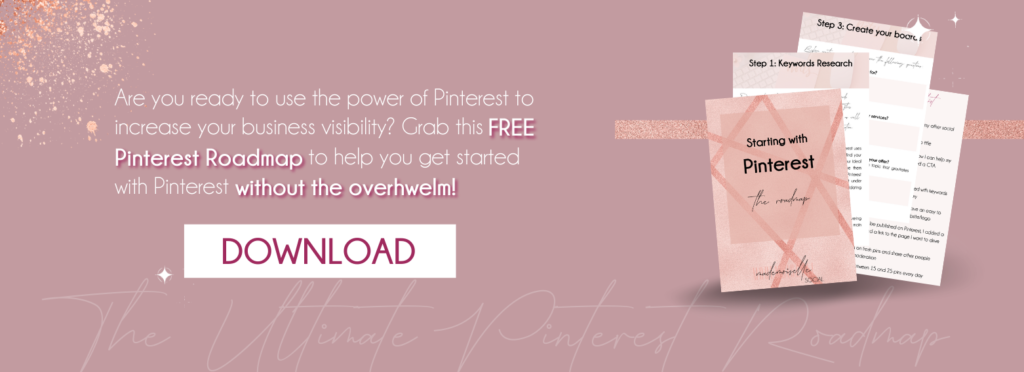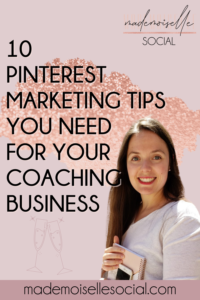About me
I'm Domitille! I help service based businesses DIY their Pinterest marketing so they can create a sustainable visibility strategy for their business.
This post contains affiliate links which means I may earn a commission, at no cost to you, if you click on one of them. Learn more here.
Marketing your coaching business on Pinterest can feel like a long list of rules and to-dos and overwhelming information! Let me cut through the noise for you! Here are my 10 Pinterest marketing tips to make sure you’re doing Pinterest marketing the right way for your business! I have to warn you, it’s long… So grab a tea and cozy up to read these 10 Pinterest tips you should keep in mind!
Pinterest marketing tip number 1: Determine your goal
Why do you need a goal to start marketing your business on Pinterest?
Alright, first one, really simple, you need a goal! You can’t be on Pinterest without a goal.
You need to know what you want Pinterest to do for you. This is the foundation for your Pinterest strategy and it will dictate a lot of your choices down the road!
A goal will ensure that you are publishing the right type of content on Pinterest, for example. It will also make it easy for you to assess your effort and the return on investment, time, or money.
How do you determine your Pinterest goal?
I want you to think about these two questions:
What is your main business goal this year? How can Pinterest help you achieve it?
Let’s say you want to grow your email list! You’ll need to make sure that the content you’re publishing on Pinterest will help you do that! Therefore, you know you need a freebie to start with. You also need to create pins that lead to the freebie landing page. And finally, you need to make sure your email sequence is ready to welcome your new subscribers.
Common Pinterest goals
- Grow your business visibility
- Increase email subscribers
- Lead generation
- Increase sales of digital products
- Increase Podcast downloads
Clearly stating a goal is one of the most overlooked Pinterest marketing tips, which is too bad. It is so important to know where you want to go to be successful with your Pinterest strategy.
psst: If you’re getting started with Pinterest and want to make sure you know what to do, I have the perfect guide to help you! The best part? It’s free! Download the Pinterest Roadmap to set your goal, optimize your account, and start pinning in no time!
Pinterest marketing tip number 2: Do a keyword research
Before even thinking about publishing your pins on Pinterest, you need to know what keywords you will be targeting! Pinterest SEO and keyword research are two Pinterest “strategies” you probably heard about, but there are much more than “strategies”. They are the foundation of everything you’ll be doing on Pinterest! From optimizing your account (see number 3) to creating your pins to publishing them! It’s all linked to the keywords you’ll be targeting on Pinterest.
When it comes to Pinterest keywords, you want to make it easy on you though! I highly recommend you actually make a list of these keywords and that you save it! You want to be able to use this list every time you’re creating content and publishing it on Pinterest. Start by listing out your main topics. Then write down all the keywords that are relevant to these topics and your audience.
This is more than a Pinterest marketing tip. It is a non-negotiable step if you want to create a successful Pinterest marketing!
Pinterest marketing tip number 3: Optimize your profile!
The third one is still very relevant, even if you’ve probably heard of it already. You have to OPTIMIZE YOUR PINTEREST PROFILE. There’s no way around it! If you want Pinterest to send you qualified traffic and leads, you need to make sure it’s set up properly. You need to take the time to optimize your Pinterest account.
Optimizing Pinterest is giving the platform the right information so they can categorize your account the right way. It’s basically telling Pinterest who you are, what you do, what your content is about, and who you target. You’re doing that by using the keywords you found (Pinterest marketing tip number 2, remember?).
It is even more important now that more and more businesses are marketing themselves on Pinterest. You can’t skip this step, it is a crucial part of your Pinterest strategy, just like your keywords!
Related: 5 easy steps to optimize your Pinterest profile
You probably realized by now that our first few Pinterest marketing tips are pretty much following the steps of getting started with the platform!
Pinterest marketing tip number 4: Stop using hashtags
No more hashtags in your Pin descriptions
When Pinterest came up with hashtags, it kind of rocks the world of Pinterest marketing because we weren’t sure how we were supposed to use them. We were told to add some hashtags at the end of our descriptions, that’s pretty much it. The hashtags added the pin to a chronological feed. However, last year, Pinterest realized that pinners were simply not using them to find content which made them pretty much useless. It is as simple as that, hashtags are useless, stop using them in your pin descriptions. Instead, use this space to add more longtail keywords to your descriptions.
Absolutely no hashtag on your Pinterest profile!
This one’s not new. Using hashtags on your profile (name, your profile description, board titles, and board descriptions) was always a waste of “keyword real estate”. Your profile is searchable and it needs to use words that people would actually look for to pop up in the results of “accounts” and “boards”. By using hashtags there, you’re losing an opportunity to actually add a keyword that people use.
Ditch the hashtags and focus on a description that uses the keywords (I think you see why there’s no way around my second Pinterest tip!) you found! It’s a better use of your keyword real estate!
Pinterest marketing tip number 5: Don’t use the word “free”
Another Pinterest marketing tip about your pins: Avoid the word “free” on the text overlay and in the pin title.
You need to remember that Pinterest is all about the user experience and they don’t like clickbait strategy! They want to make sure that what is advertised on a pin is what the user will get. Unfortunately, the word “free” is too much of a clickbait for Pinterest. They advised marketers to stop using it on the overlay of the pins and in the pin titles.
One little bonus tip about words, avoid the word “click” in your pin titles! “Click” should only be used as a call to action and you should keep it for the description!

Pinterest marketing tip number 6: Focus on fresh pins
Here we are the famous fresh pins! They caused a lot of trouble for the content creators on Pinterest because they meant that Pinterest wanted more content! It was only a matter of time before users run out of content they’ve already consumed and get bored of seeing the same pins again and again in their feed.
So, Pinterest started giving a little boost to “fresh pins”. You know, new images that haven’t been published yet but that can lead to the same URL. It also meant that pinning a lot of other people’s pins shouldn’t be a core strategy anymore.
BUT, a few months ago, Pinterest hinted that they wanted more “new URLs”. According to them, a feed composed of different images leading to the same URLs is not an ideal experience either… And I kind of agree… Don’t you?
Bottom line, if you want Pinterest to work for you in 2021, focus on fresh pins AND brand new content.
The last three Pinterest marketing tips we covered focused on the creation of your pins and some pinning strategy.
Pinterest marketing number 7: Repurpose your content
How to create your content with Pinterest in mind
So number 6 might be a little disheartening, right? The focus on fresh pins and brand new content means that we need to spend more time on creating content. That task is often time-consuming and feels like a never-ending process.
Although, it doesn’t have to be!
You can repurpose your content super easy if you start your content creation process with Pinterest in mind. I like to create content for the platforms that are more demanding first, aka Pinterest and its “fresh pins”. Then, I can easily repurpose it for other platforms.
My 7th Pinterest marketing tip is to start your content creation with blog posts. First because, it’s easy to repurpose, second because, they work best on Pinterest.
Why blogs are awesome
Blogs are great because they give the opportunity to a cold lead to get to know you without too much investment. They are long enough to warm them up to you and help you position yourself as an expert!
They are AWESOME because they’re super easy to REPURPOSE!
Think about it, blogs are usually a longer type of content. You can pretty much copy and paste your paragraphs as Instagram posts. If you have list-type blog posts, they can be used to create Instagram reels in no time! Or cute little design posts!
You can reuse your blogs, or part of them, for your email list. Plus, you can easily talk about your last published blog on Instagram stories.
What if you don’t blog at all? As a business coach, you probably have other types of content such as Podcast episodes or YouTube videos. You can repurpose them into blogs and satisfy Pinterest’s appetite for new content. Use the podcast show notes as a blog and embed the YouTube videos on your blog. Don’t forget to add some texts for SEO purposes if you embed your videos.
And voilà, a brand new blog (that you can now repurpose into Instagram posts, reels, email, etc…)!
Pinterest marketing tip number 8: Tailwind is your best friend!
Pinterest marketing can be time-consuming
One of the best Pinterest marketing tips I can give you is to work smarter when it comes to your Pinterest strategy! On top of creating new content, you need to be feeding this new content to Pinterest consistently. It means creating the pins to go with the content and actually publishing them on Pinterest. It is time-consuming. Unless you have hours to work on the implementation of your Pinterest marketing, you’ll feel exhausted, and even a little bored, very quickly! As a business coach, you probably don’t have that kind of time anyway!
Why you should use an automatic scheduler
Lucky for us, we’ve got Tailwind! It’s an automatic scheduler and a lifesaver when it comes to Pinterest marketing. If you’re serious about using Pinterest for your coaching business, you’ll absolutely want to use Tailwind!
The main reason you’d want to use Tailwind is that you can schedule your pins ahead of time! For example, I schedule all my clients’ content for the month in one sitting. That gives me more time to focus on the strategic parts like SEO descriptions and analyzing the data. It allows you to batch the scheduling instead of having to manually schedule your pins every day on Pinterest.
But on top of that, it gives you access to communities. It is a place where you can add your pins and where people can add them into their own schedule. It’s a collaborative space so you’d have to share pins as well but it makes it much easier (and faster) to find quality content to reshare.
The last thing to consider is that you do get more analytics as well, especially the performance of your boards which is helpful when reviewing your strategy!
Tailwind is so worth the $15 per month, trust me! The best part is that you can try it for free before deciding if you want to use it!

The two Pinterest marketing tips you just read are helping you with time-management and giving as much exposure as your can to your content.
Pinterest marketing tip number 9: Think outside of Pinterest
Pinterest Marketing is not really about Pinterest
To be successful on Pinterest, you need to think outside of Pinterest. What? Yes, outside of Pinterest!
Pinterest is a traffic driver, it can do wonders for your growth because it drives people to places where they can interact with your content, buy your products, book your coaching services, etc… However, what happens when users leave Pinterest and arrive on your page, well, that is all on you! The conversion part is your end of the bargain!
Ok so clearly, what I mean is that it is super important for you to know exactly what you want pinners to do when they arrive on your landing pages. You need to map out your customer journey, otherwise known as your sales funnel…
Pinterest sales funnels
Knowing the exact steps you want people to take from Pinterest to your end goal will make all the difference when it comes to converting Pinterest traffic into subscribers or buyers.
Your first funnel doesn’t have to be complicated at all! Creating a simple sales funnel will help you with visualizing your customer journey. You can use the following formula to get started:
Pinterest > Landing Page > Action You Want Them to Take on Your Landing Page > Where Does it Lead Them > Action You Want Them to Take There > End Goal (the one we talked about for our 1st Pinterest marketing tip)
You can add as many “action you want them to take” items but you should map out the exact steps they will take from the moment they click on your pins to the moment your goal is met.
This is one of my favorite Pinterest marketing tips! Coming up with your funnels is fun and so valuable for your success!
Pinterest marketing number 10: Use your analytics!
Pinterest Analytics
Use your analytics to analyze how your Pinterest marketing strategy performs. Our number one advice was for you to set a goal, remember?
Well, you’ll use Pinterest analytics to see if your efforts are getting you closer to this goal!
To access your analytics, you can log on to Pinterest and choose Analytics > Overview at the top of the page.
Look at the number of clicks your claimed website is receiving, and the top pins in terms of link click. These two numbers will give you an idea of what content works best for your audience as well as the designs they engage with the most. But…
…You also need Google Analytics.
Pinterest records traffic differently than Google. Since your main goal is to get your audience to engage with the landing page they’ve been sent to, you want to double-check how it is received on google! So you’ll also need to check Google Analytics!
When you log in to google analytics, you can double-check how many users google counted coming from Pinterest!
Go to Acquisition > All traffic > Overview > Social.
There you’ll see how many users Pinterest sent you for the timeframe you chose according to Google analytics.
In order to see what pins are sending you the most traffic, you can follow this path:
Acquisition > All traffic > Referrals > Pinterest
You’ll end up on a page with the referral path of the users. It basically means the pin they clicked on and that led them to the landing page.
There’s obviously a lot more information you can get from these two analytics tools but I’m trying to keep it beginner-friendly!
That was our last two Pinterest marketing tips! They should help you with incorporating Pinterest into your overall business strategy!
There you have it, my 10 Pinterest marketing tips for business coaches! These 10 Pinterest tips should help you make sense of what it takes to market your online business on Pinterest and help you create a sustainable marketing plan!
Like This Article? Share it on Pinterest!
Other Pinterest topics you might be interested in:
Leave a Reply Cancel reply
This site uses cookies to ensure you get the best experience. By using our website you agree to our Privacy policy and our cookies usage.
Got it, thanks!


